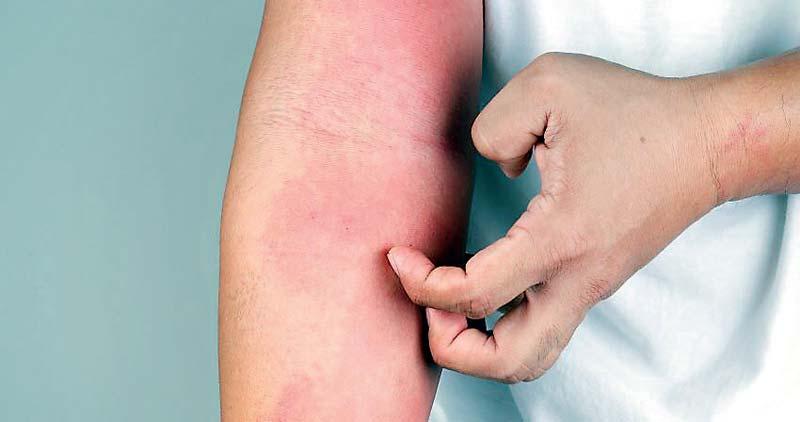17 Dec 2021 - {{hitsCtrl.values.hits}}

| If over-the-counter treatments fail to control atopic eczema, then it is time to see a physician |
 The word eczema comes from the Greek word for bubbling. It is a weeping, oozing itchy eruption that has many causes, the most common being atopic eczema. Other causes include allergic contact dermatitis, irritant contact dermatitis, seborrheic dermatitis, stasis dermatitis, pompholyx (dyshidrotic eczema), and xerosis.
The word eczema comes from the Greek word for bubbling. It is a weeping, oozing itchy eruption that has many causes, the most common being atopic eczema. Other causes include allergic contact dermatitis, irritant contact dermatitis, seborrheic dermatitis, stasis dermatitis, pompholyx (dyshidrotic eczema), and xerosis.
Atopic eczema is now thought to be related to defective production of skin protein called filaggrin in many cases. Although a predisposition to atopic eczema can be inherited, it is not transmissible from person to person.
Environmental factors play an important role in triggering atopic eczema. It is not unusual for patients with atopic eczema to note that sweating during exercise, using harsh detergents, or wearing wool clothing can produce itching and trigger flares of atopic eczema. (dermatitis) is a general Swelling, oozing, and crusting are all signs of atopic eczema. In a practical sense, all four characteristics (swelling, oozing, crusting, and itching) probably all occur simultaneously.
Atopic eczema usually begins in infancy or early childhood. Since many children slobber at this age, the saliva will evaporate and dry out the skin of the face, producing dermatitis on the cheeks. Children in diapers also often have eczema on their elbows and knees. Eczema typically does not affect the diaper area. In adults, the pattern is somewhat different; eczema most commonly affects the skin folds opposite the elbows and knees. In addition, the neck, wrists, and ankles often have lesions.
Good skin care means that the skin should be kept moist. This is particularly important in children or adults who have atopic eczema. After a shower or bath, before towel drying, a thin layer of an emollient (a greasy substance which water cannot penetrate) should be applied to the wet skin to inhibit the evaporation of skin moisture. If over-the-counter treatments fail to control atopic eczema, then it is time to see a physician.
It may be necessary to prescribe topical steroids to control acute flares of dermatitis.
Occasionally, other anti-inflammatory oral medications may be required for short-term control, and even ultraviolet light exposures can help manage serious persistent cases.
Top tips for managing your eczema
1. Establish a good daily skincare routine and try to stick to it. Don’t stop moisturizing when your skin is clear. Apply emollients in a smooth, downward motion in the direction of hair growth. Teach your child how to apply their emollients correctly from a young age. Wear cotton clothing where possible
2. Remember – avoid soap! Ideally, shampoos should be clear, pH neural and fragrance free. Your bath or shower should be a lukewarm temperature; 5-7 minutes bathing is enough. After your bath/shower, pat your skin dry. It is a great time to apply emollient all over. If you can’t reach your back, sponges with long handles can be useful.
3. Dry skin itches – take your moisturizers everywhere. Keep a supply at work, in your handbag, in your child’s schoolbag, at the crèche and school. Adults should use approximately 500g of emollient per week and 250g for children.
4. When eczema flares, treat at the first sign of symptoms. Use topical steroids for eczema flares as recommended by your healthcare professional. As your child grows, ask for a review – they may need adjustment of their treatment.
5. If skin becomes wet, weepy, red and very itchy – think infection and seek medical advice. Always keep fingernails short.
6. During warm weather or exercise, stay cool; remember sweat can aggravate eczema. Protect your skin from changes in temperature, e.g. during colder weather wrap up well when moving from centrally-heated environments into cold outdoor conditions.
7. Use a non-biological washing powder and avoid fabric conditioner. Avoid fragranced candles and plug-in air-freshener around the home. Avoid chemical sprays and harsh household cleaning products.
8. Reduce the dust mite at home; dust and vacuum regularly, wash bedding weekly at 60 degrees and replace curtains and carpets if possible.
9. Children’s soft toys should be washed regularly (follow manufacturers’ instructions but temperature must reach 60° C), or put them in the freezer for 24 hours to kill house dust mites.
10. Freshly dry-cleaned clothes should be removed from plastic and allowed to air for 24 hours before wearing, to reduce the risk of possible chemical irritation of the skin.
11. Protect your hands - wear cotton gloves under protective gloves if you work with chemicals or cement. Wear barrier hand-cream if you need to constantly wash your hands.
(The writer holds an MBBS; MD Dermatology and has an International Dermatology Fellowship (USA), SL& NSC Fellowship (Singapore), possesses a Diploma in American Academy of Aesthetic Medicine(A3M), Diploma in American Academe of Anti - Ageing & Regenerative Medicine (A4M) and is a Consultant Dermatologist & Specialist in Cosmetology)
29 Apr 2024 13 minute ago
29 Apr 2024 18 minute ago
28 Apr 2024 9 hours ago
28 Apr 2024 28 Apr 2024
28 Apr 2024 28 Apr 2024